钠离子电池研究进展
- 格式:pdf
- 大小:760.83 KB
- 文档页数:12
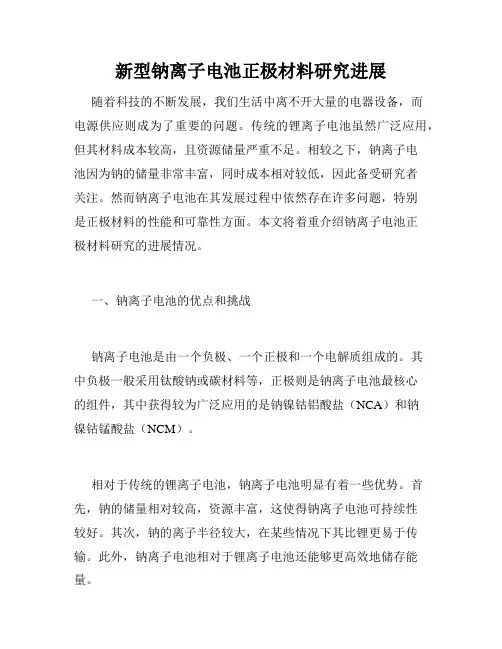
新型钠离子电池正极材料研究进展随着科技的不断发展,我们生活中离不开大量的电器设备,而电源供应则成为了重要的问题。
传统的锂离子电池虽然广泛应用,但其材料成本较高,且资源储量严重不足。
相较之下,钠离子电池因为钠的储量非常丰富,同时成本相对较低,因此备受研究者关注。
然而钠离子电池在其发展过程中依然存在许多问题,特别是正极材料的性能和可靠性方面。
本文将着重介绍钠离子电池正极材料研究的进展情况。
一、钠离子电池的优点和挑战钠离子电池是由一个负极、一个正极和一个电解质组成的。
其中负极一般采用钛酸钠或碳材料等,正极则是钠离子电池最核心的组件,其中获得较为广泛应用的是钠镍钴铝酸盐(NCA)和钠镍钴锰酸盐(NCM)。
相对于传统的锂离子电池,钠离子电池明显有着一些优势。
首先,钠的储量相对较高,资源丰富,这使得钠离子电池可持续性较好。
其次,钠的离子半径较大,在某些情况下其比锂更易于传输。
此外,钠离子电池相对于锂离子电池还能够更高效地储存能量。
但钠离子电池也存在一些问题。
首先,尽管钠的储量并不算紧缺,但是相比锂离子电池的运用,市场落后,应用性不足。
其次,钠离子电池的循环寿命较短,高温环境下会出现失活现象,尤其是正极材料的稳定性存在一定问题。
二、目前存在的钠离子电池正极材料问题随着钠离子电池的不断发展,正极材料的性能和可靠性方面已经成为电池技术研究重点。
当前,钠离子电池主要存在三方面问题与挑战:1、快速充放电钠离子电池的正极材料要能够快速充放电,这需要其在循环过程中保持很好的电化学稳定性。
同时,正极材料的电导率也应该便于离子的传输,以保证充电效率。
2、热学稳定性虽说里约卓尔根据数据推导,钠离子电池具有比锂离子电池更高的热值密度,但钠离子电池的溶剂在极高的温度下会发生挥发,甚至导致热失控。
因此,在钠离子电池选材时,必须确保材料热学稳定性。
3、寿命钠离子电池的使用寿命主要受到正极材料在充放电循环间的失活程度所影响。
正极材料的电化学稳定性、晶格稳定性等都会影响充放电周期和循环性能。
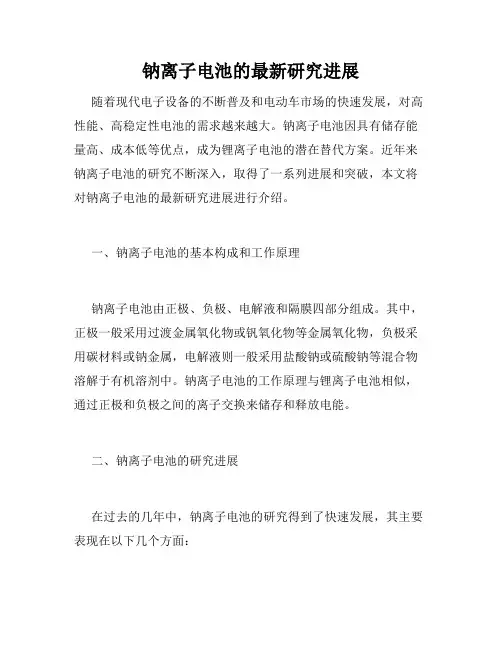
钠离子电池的最新研究进展随着现代电子设备的不断普及和电动车市场的快速发展,对高性能、高稳定性电池的需求越来越大。
钠离子电池因具有储存能量高、成本低等优点,成为锂离子电池的潜在替代方案。
近年来钠离子电池的研究不断深入,取得了一系列进展和突破,本文将对钠离子电池的最新研究进展进行介绍。
一、钠离子电池的基本构成和工作原理钠离子电池由正极、负极、电解液和隔膜四部分组成。
其中,正极一般采用过渡金属氧化物或钒氧化物等金属氧化物,负极采用碳材料或钠金属,电解液则一般采用盐酸钠或硫酸钠等混合物溶解于有机溶剂中。
钠离子电池的工作原理与锂离子电池相似,通过正极和负极之间的离子交换来储存和释放电能。
二、钠离子电池的研究进展在过去的几年中,钠离子电池的研究得到了快速发展,其主要表现在以下几个方面:1.大容量正负极材料的发现正负极材料的容量决定了电池的储能能力,因此大容量正负极材料的发现是钠离子电池研究中的重要进展。
钒氧化物和过渡金属氧化物等大容量正极材料被广泛应用于钠离子电池中。
此外,负极材料中的钠金属也显示出良好的储能性能。
2. 高性能电解质的研究电解质的性能对于钠离子电池的循环性能和安全性能起到至关重要的作用。
现有研究表明,采用高浓度盐酸钠或硫酸钠的电解质可以获得更好的电化学性能和稳定性能。
此外,具有热稳定性和低粘度的电解质也被广泛研究,以提高电池的安全性能。
3.智能化锂离子电池智能化管理系统的研究智能化管理系统可以通过数据传输、温度监控等手段实现对电池的及时调控和管理。
这在大规模应用钠离子电池的场景中尤其重要。
目前,钠离子电池的智能化管理系统正在被广泛研究,以提高其在工业和交通领域的应用价值。
4.钠离子电池的应用目前,钠离子电池的应用领域相对较少,但随着钠离子电池性能的不断提高和成本的降低,其应用前景非常广泛。
钠离子电池将广泛应用于电动汽车、智能家居、可再生能源储存等领域。
三、结论总的来说,钠离子电池作为一种新兴的电池技术,具有很大的开发潜力。
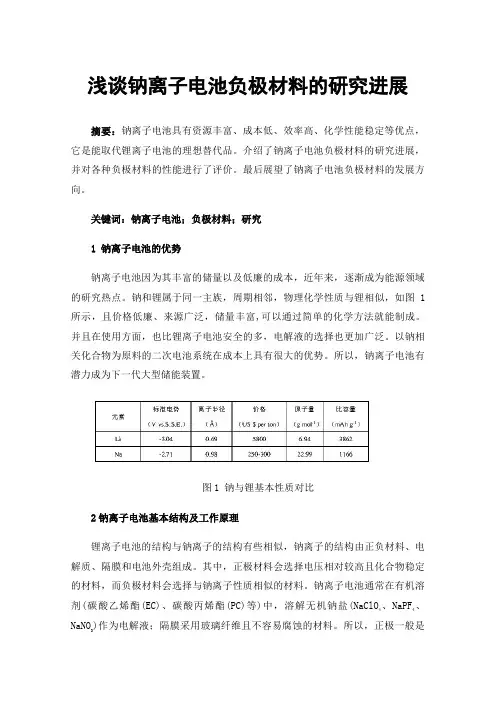
浅谈钠离子电池负极材料的研究进展摘要:钠离子电池具有资源丰富、成本低、效率高、化学性能稳定等优点,它是能取代锂离子电池的理想替代品。
介绍了钠离子电池负极材料的研究进展,并对各种负极材料的性能进行了评价。
最后展望了钠离子电池负极材料的发展方向。
关键词:钠离子电池;负极材料;研究1钠离子电池的优势钠离子电池因为其丰富的储量以及低廉的成本,近年来,逐渐成为能源领域的研究热点。
钠和锂属于同一主族,周期相邻,物理化学性质与锂相似,如图1所示,且价格低廉、来源广泛,储量丰富,可以通过简单的化学方法就能制成。
并且在使用方面,也比锂离子电池安全的多,电解液的选择也更加广泛。
以钠相关化合物为原料的二次电池系统在成本上具有很大的优势。
所以,钠离子电池有潜力成为下一代大型储能装置。
图1 钠与锂基本性质对比2钠离子电池基本结构及工作原理锂离子电池的结构与钠离子的结构有些相似,钠离子的结构由正负材料、电解质、隔膜和电池外壳组成。
其中,正极材料会选择电压相对较高且化合物稳定的材料,而负极材料会选择与钠离子性质相似的材料。
钠离子电池通常在有机溶剂(碳酸乙烯酯(EC)、碳酸丙烯酯(PC)等)中,溶解无机钠盐(NaClO4、NaPF4、NaNO3)作为电解液;隔膜采用玻璃纤维且不容易腐蚀的材料。
所以,正极一般是用铝箔,而负极用的是铜箔。
钠离子电池的能量存储和释放,是在钠离子在正负极材料中,不断的进行嵌入和剥离,因而,被人们所称为“摇椅式电池”。
钠离子电池的工作原理如图2所示。
图2 钠离子电池的工作原理3钠离子电池的介绍3.1水系钠离子电池钠离子电池的工作原理与锂离子电池的工作原理相似。
基于摇椅电池机制,钠离子可逆地嵌入并从正负电极中去除。
在电池充电过程中,钠离子从内部电路的正极分离,并通过电解液进入到负极,而电子从正极移动到外部电路的负极。
放电的过程与充电过程相反,钠离子从负极中脱出,通过电解液移动到正极,电子通过外部电路到达负极。
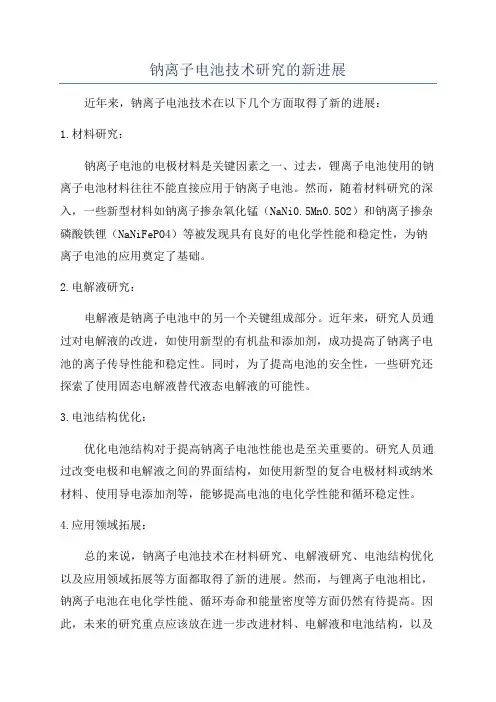
钠离子电池技术研究的新进展
近年来,钠离子电池技术在以下几个方面取得了新的进展:
1.材料研究:
钠离子电池的电极材料是关键因素之一、过去,锂离子电池使用的钠离子电池材料往往不能直接应用于钠离子电池。
然而,随着材料研究的深入,一些新型材料如钠离子掺杂氧化锰(NaNi0.5Mn0.5O2)和钠离子掺杂磷酸铁锂(NaNiFePO4)等被发现具有良好的电化学性能和稳定性,为钠离子电池的应用奠定了基础。
2.电解液研究:
电解液是钠离子电池中的另一个关键组成部分。
近年来,研究人员通过对电解液的改进,如使用新型的有机盐和添加剂,成功提高了钠离子电池的离子传导性能和稳定性。
同时,为了提高电池的安全性,一些研究还探索了使用固态电解液替代液态电解液的可能性。
3.电池结构优化:
优化电池结构对于提高钠离子电池性能也是至关重要的。
研究人员通过改变电极和电解液之间的界面结构,如使用新型的复合电极材料或纳米材料、使用导电添加剂等,能够提高电池的电化学性能和循环稳定性。
4.应用领域拓展:
总的来说,钠离子电池技术在材料研究、电解液研究、电池结构优化以及应用领域拓展等方面都取得了新的进展。
然而,与锂离子电池相比,钠离子电池在电化学性能、循环寿命和能量密度等方面仍然有待提高。
因此,未来的研究重点应该放在进一步改进材料、电解液和电池结构,以及
提高钠离子电池的可靠性和安全性上。
随着研究的深入,钠离子电池有望成为一种具有广泛应用前景的新兴能源存储技术。
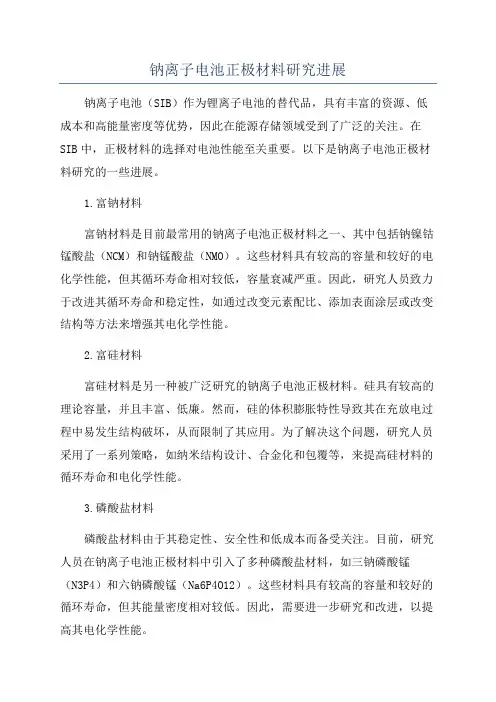
钠离子电池正极材料研究进展钠离子电池(SIB)作为锂离子电池的替代品,具有丰富的资源、低成本和高能量密度等优势,因此在能源存储领域受到了广泛的关注。
在SIB中,正极材料的选择对电池性能至关重要。
以下是钠离子电池正极材料研究的一些进展。
1.富钠材料富钠材料是目前最常用的钠离子电池正极材料之一、其中包括钠镍钴锰酸盐(NCM)和钠锰酸盐(NMO)。
这些材料具有较高的容量和较好的电化学性能,但其循环寿命相对较低,容量衰减严重。
因此,研究人员致力于改进其循环寿命和稳定性,如通过改变元素配比、添加表面涂层或改变结构等方法来增强其电化学性能。
2.富硅材料富硅材料是另一种被广泛研究的钠离子电池正极材料。
硅具有较高的理论容量,并且丰富、低廉。
然而,硅的体积膨胀特性导致其在充放电过程中易发生结构破坏,从而限制了其应用。
为了解决这个问题,研究人员采用了一系列策略,如纳米结构设计、合金化和包覆等,来提高硅材料的循环寿命和电化学性能。
3.磷酸盐材料磷酸盐材料由于其稳定性、安全性和低成本而备受关注。
目前,研究人员在钠离子电池正极材料中引入了多种磷酸盐材料,如三钠磷酸锰(N3P4)和六钠磷酸锰(Na6P4O12)。
这些材料具有较高的容量和较好的循环寿命,但其能量密度相对较低。
因此,需要进一步研究和改进,以提高其电化学性能。
4.氧化物材料氧化物材料,如氧化钠钛(Na2Ti3O7)和氧化钠铁(NaFeO2),因其稳定性和良好的循环性能备受关注。
这些材料具有较高的反应动力学和稳定性,可用于高功率和长循环寿命的钠离子电池。
此外,氧化物材料还有利于提高电池的安全性能。
总的来说,钠离子电池正极材料的研究进展涵盖了富钠材料、富硅材料、磷酸盐材料和氧化物材料等。
这些材料在提高钠离子电池的能量密度、循环寿命和安全性方面发挥着重要的作用。
随着对钠离子电池的深入研究和快速发展,相信这些材料的性能将得到进一步改善和优化,为更多的应用场景提供可靠的解决方案。
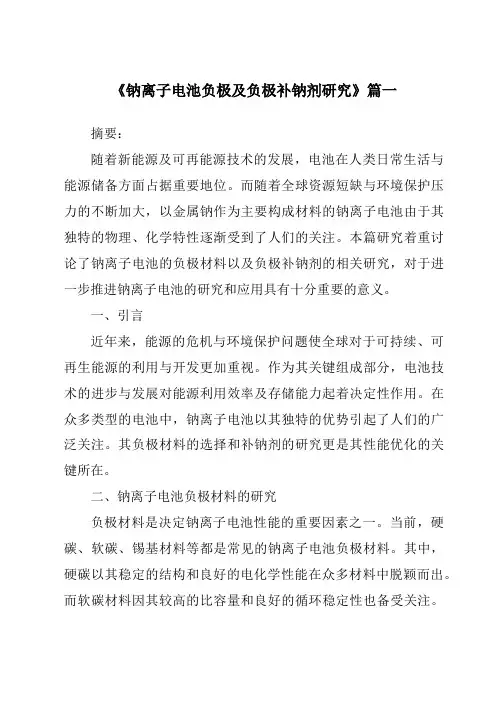
《钠离子电池负极及负极补钠剂研究》篇一摘要:随着新能源及可再能源技术的发展,电池在人类日常生活与能源储备方面占据重要地位。
而随着全球资源短缺与环境保护压力的不断加大,以金属钠作为主要构成材料的钠离子电池由于其独特的物理、化学特性逐渐受到了人们的关注。
本篇研究着重讨论了钠离子电池的负极材料以及负极补钠剂的相关研究,对于进一步推进钠离子电池的研究和应用具有十分重要的意义。
一、引言近年来,能源的危机与环境保护问题使全球对于可持续、可再生能源的利用与开发更加重视。
作为其关键组成部分,电池技术的进步与发展对能源利用效率及存储能力起着决定性作用。
在众多类型的电池中,钠离子电池以其独特的优势引起了人们的广泛关注。
其负极材料的选择和补钠剂的研究更是其性能优化的关键所在。
二、钠离子电池负极材料的研究负极材料是决定钠离子电池性能的重要因素之一。
当前,硬碳、软碳、锡基材料等都是常见的钠离子电池负极材料。
其中,硬碳以其稳定的结构和良好的电化学性能在众多材料中脱颖而出。
而软碳材料因其较高的比容量和良好的循环稳定性也备受关注。
此外,锡基材料因其高理论容量和低工作电压也具有较大的应用潜力。
三、负极补钠剂的研究在钠离子电池中,补钠剂的作用是补充在充放电过程中损失的钠离子,从而提高电池的能量密度和循环稳定性。
目前,常见的补钠剂包括有机化合物和无机化合物。
其中,有机化合物具有较高的容量和较好的循环性能,而无机化合物则具有较高的离子电导率和良好的热稳定性。
然而,由于它们各自存在的缺陷,如何找到一种性能优异的补钠剂仍是一个重要的研究方向。
四、新型负极补钠剂的研究进展近年来,科研人员对新型的补钠剂进行了广泛的研究和探索。
例如,一些新型的有机复合材料由于其优良的电化学性能和良好的热稳定性被广泛研究。
同时,一些新型的无机补钠剂因其优异的离子电导率和环境友好性也备受关注。
此外,通过复合使用有机和无机补钠剂,可以有效地结合两者的优点,进一步提高电池的性能。
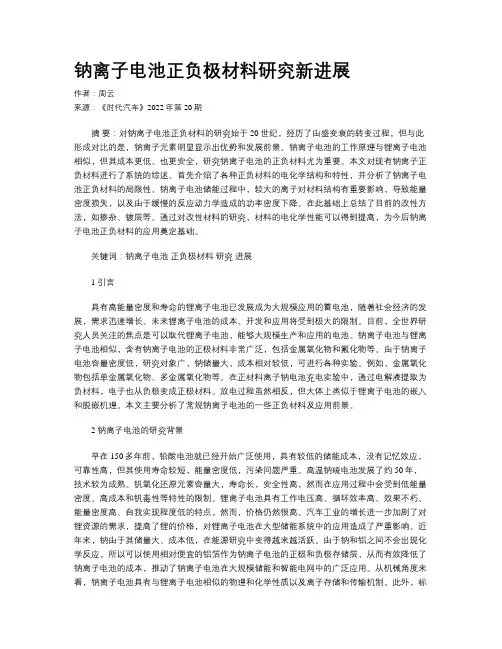
钠离子电池正负极材料研究新进展作者:周云来源:《时代汽车》2022年第20期摘要:对钠离子电池正负材料的研究始于20世纪,经历了由盛变衰的转变过程,但与此形成对比的是,钠离子元素明显显示出优势和发展前景。
钠离子电池的工作原理与锂离子电池相似,但其成本更低、也更安全,研究钠离子电池的正负材料尤为重要。
本文对现有钠离子正负材料进行了系统的综述。
首先介绍了各种正负材料的电化学结构和特性,并分析了钠离子电池正负材料的局限性。
钠离子电池储能过程中,较大的离子对材料结构有重要影响,导致能量密度损失,以及由于缓慢的反应动力学造成的功率密度下降。
在此基础上总结了目前的改性方法,如掺杂、镀层等。
通过对改性材料的研究,材料的电化学性能可以得到提高,为今后钠离子电池正负材料的应用奠定基础。
关键词:钠离子电池正负极材料研究进展1 引言具有高能量密度和寿命的锂离子电池已发展成为大规模应用的蓄电池,随着社会经济的发展,需求迅速增长。
未来锂离子电池的成本、开发和应用将受到极大的限制。
目前,全世界研究人员关注的焦点是可以取代锂离子电池,能够大规模生产和应用的电池。
钠离子电池与锂离子电池相似,含有钠离子电池的正极材料非常广泛,包括金属氧化物和氟化物等。
由于钠离子电池容量密度低,研究对象广,钠储量大,成本相对较低,可进行各种实验。
例如,金属氧化物包括单金属氧化物、多金属氧化物等。
在正材料离子钠电池充电实验中,通过电解液提取为负材料,电子也从负极变成正极材料。
放电过程虽然相反,但大体上类似于锂离子电池的嵌入和脱嵌机理。
本文主要分析了常规钠离子电池的一些正负材料及应用前景。
2 钠离子电池的研究背景早在150多年前,铅酸电池就已经开始广泛使用,具有较低的储能成本,没有记忆效应,可靠性高,但其使用寿命较短,能量密度低,污染问题严重。
高温钠硫电池发展了约50年,技术较为成熟。
钒氧化还原元素容量大,寿命长,安全性高,然而在应用过程中会受到低能量密度、高成本和钒毒性等特性的限制。
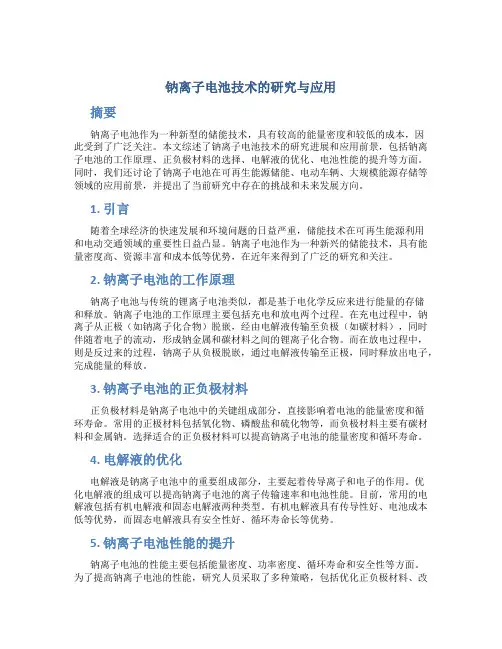
钠离子电池技术的研究与应用摘要钠离子电池作为一种新型的储能技术,具有较高的能量密度和较低的成本,因此受到了广泛关注。
本文综述了钠离子电池技术的研究进展和应用前景,包括钠离子电池的工作原理、正负极材料的选择、电解液的优化、电池性能的提升等方面。
同时,我们还讨论了钠离子电池在可再生能源储能、电动车辆、大规模能源存储等领域的应用前景,并提出了当前研究中存在的挑战和未来发展方向。
1. 引言随着全球经济的快速发展和环境问题的日益严重,储能技术在可再生能源利用和电动交通领域的重要性日益凸显。
钠离子电池作为一种新兴的储能技术,具有能量密度高、资源丰富和成本低等优势,在近年来得到了广泛的研究和关注。
2. 钠离子电池的工作原理钠离子电池与传统的锂离子电池类似,都是基于电化学反应来进行能量的存储和释放。
钠离子电池的工作原理主要包括充电和放电两个过程。
在充电过程中,钠离子从正极(如钠离子化合物)脱嵌,经由电解液传输至负极(如碳材料),同时伴随着电子的流动,形成钠金属和碳材料之间的锂离子化合物。
而在放电过程中,则是反过来的过程,钠离子从负极脱嵌,通过电解液传输至正极,同时释放出电子,完成能量的释放。
3. 钠离子电池的正负极材料正负极材料是钠离子电池中的关键组成部分,直接影响着电池的能量密度和循环寿命。
常用的正极材料包括氧化物、磷酸盐和硫化物等,而负极材料主要有碳材料和金属钠。
选择适合的正负极材料可以提高钠离子电池的能量密度和循环寿命。
4. 电解液的优化电解液是钠离子电池中的重要组成部分,主要起着传导离子和电子的作用。
优化电解液的组成可以提高钠离子电池的离子传输速率和电池性能。
目前,常用的电解液包括有机电解液和固态电解液两种类型。
有机电解液具有传导性好、电池成本低等优势,而固态电解液具有安全性好、循环寿命长等优势。
5. 钠离子电池性能的提升钠离子电池的性能主要包括能量密度、功率密度、循环寿命和安全性等方面。
为了提高钠离子电池的性能,研究人员采取了多种策略,包括优化正负极材料、改变电解液组成、改善电池结构等。
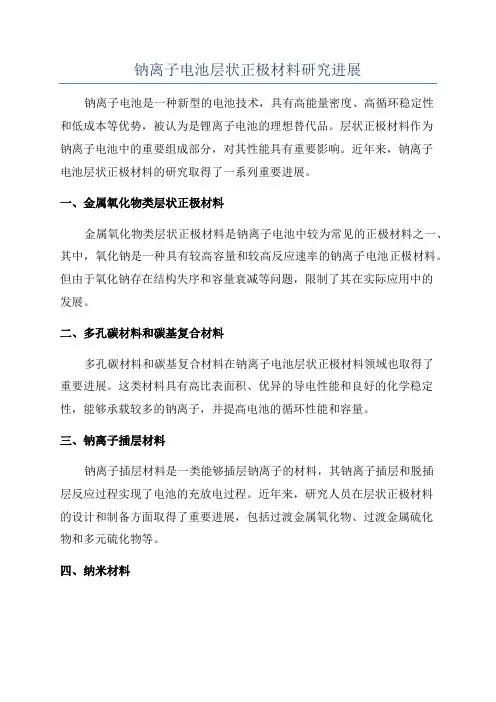
钠离子电池层状正极材料研究进展钠离子电池是一种新型的电池技术,具有高能量密度、高循环稳定性和低成本等优势,被认为是锂离子电池的理想替代品。
层状正极材料作为钠离子电池中的重要组成部分,对其性能具有重要影响。
近年来,钠离子电池层状正极材料的研究取得了一系列重要进展。
一、金属氧化物类层状正极材料金属氧化物类层状正极材料是钠离子电池中较为常见的正极材料之一、其中,氧化钠是一种具有较高容量和较高反应速率的钠离子电池正极材料。
但由于氧化钠存在结构失序和容量衰减等问题,限制了其在实际应用中的发展。
二、多孔碳材料和碳基复合材料多孔碳材料和碳基复合材料在钠离子电池层状正极材料领域也取得了重要进展。
这类材料具有高比表面积、优异的导电性能和良好的化学稳定性,能够承载较多的钠离子,并提高电池的循环性能和容量。
三、钠离子插层材料钠离子插层材料是一类能够插层钠离子的材料,其钠离子插层和脱插层反应过程实现了电池的充放电过程。
近年来,研究人员在层状正极材料的设计和制备方面取得了重要进展,包括过渡金属氧化物、过渡金属硫化物和多元硫化物等。
四、纳米材料纳米材料在钠离子电池层状正极材料研究中也发挥着重要作用。
纳米材料具有较小的晶粒尺寸和高比表面积,能够提高层状正极材料的离子和电子传输速率,从而提高电池的性能。
此外,钠离子电池层状正极材料的界面设计和合成方法也是当前研究的重点。
优化界面结构和材料的制备工艺,能够提高层状正极材料的电化学性能,实现更高的能量密度和更长的循环寿命。
总体来说,钠离子电池层状正极材料的研究进展正在推动钠离子电池技术的发展。
未来,随着材料科学和电化学领域的不断发展,相信钠离子电池层状正极材料会不断有新的突破和创新,从而实现钠离子电池技术的商业化应用。
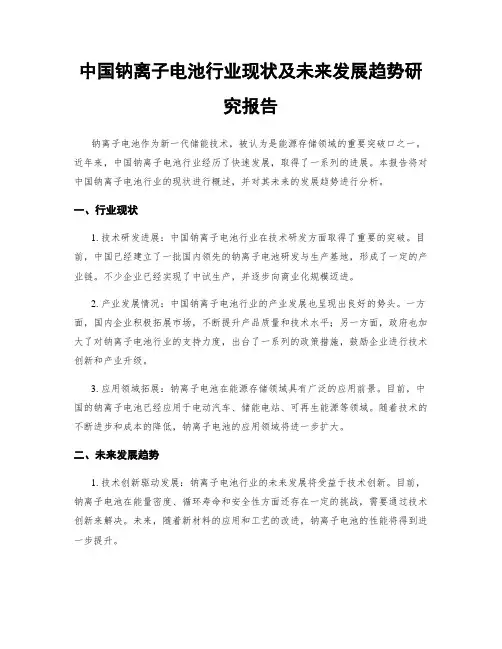
中国钠离子电池行业现状及未来发展趋势研究报告钠离子电池作为新一代储能技术,被认为是能源存储领域的重要突破口之一。
近年来,中国钠离子电池行业经历了快速发展,取得了一系列的进展。
本报告将对中国钠离子电池行业的现状进行概述,并对其未来的发展趋势进行分析。
一、行业现状1. 技术研发进展:中国钠离子电池行业在技术研发方面取得了重要的突破。
目前,中国已经建立了一批国内领先的钠离子电池研发与生产基地,形成了一定的产业链。
不少企业已经实现了中试生产,并逐步向商业化规模迈进。
2. 产业发展情况:中国钠离子电池行业的产业发展也呈现出良好的势头。
一方面,国内企业积极拓展市场,不断提升产品质量和技术水平;另一方面,政府也加大了对钠离子电池行业的支持力度,出台了一系列的政策措施,鼓励企业进行技术创新和产业升级。
3. 应用领域拓展:钠离子电池在能源存储领域具有广泛的应用前景。
目前,中国的钠离子电池已经应用于电动汽车、储能电站、可再生能源等领域。
随着技术的不断进步和成本的降低,钠离子电池的应用领域将进一步扩大。
二、未来发展趋势1. 技术创新驱动发展:钠离子电池行业的未来发展将受益于技术创新。
目前,钠离子电池在能量密度、循环寿命和安全性方面还存在一定的挑战,需要通过技术创新来解决。
未来,随着新材料的应用和工艺的改进,钠离子电池的性能将得到进一步提升。
2. 规模化生产实现成本降低:目前,钠离子电池的成本仍然较高,限制了其大规模应用。
未来,随着规模化生产的实现,钠离子电池的成本将会逐步下降。
此外,材料和工艺的改进也将有助于提高钠离子电池的生产效率和降低成本。
3. 拓展新的应用领域:随着能源存储需求的不断增长,钠离子电池在新的应用领域将有更广阔的发展空间。
除了传统的电动汽车和储能电站,钠离子电池还可以应用于智能电网、航空航天、无人机等领域。
未来,钠离子电池有望在多个领域取得重要的突破。
4. 加强产学研合作:钠离子电池行业的发展离不开产学研的紧密合作。
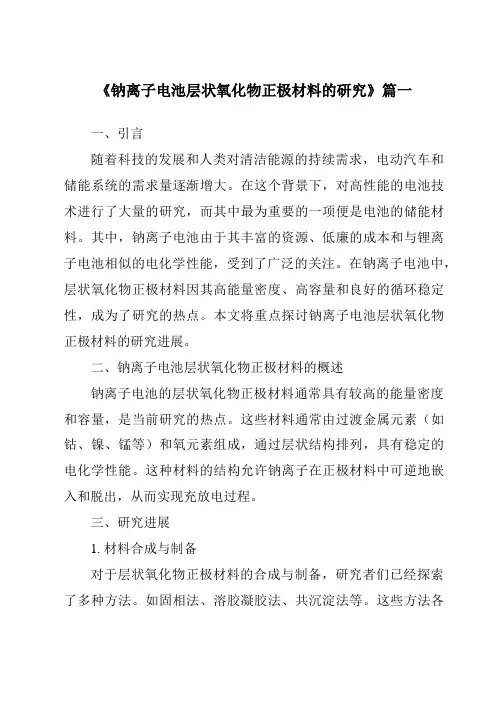
《钠离子电池层状氧化物正极材料的研究》篇一一、引言随着科技的发展和人类对清洁能源的持续需求,电动汽车和储能系统的需求量逐渐增大。
在这个背景下,对高性能的电池技术进行了大量的研究,而其中最为重要的一项便是电池的储能材料。
其中,钠离子电池由于其丰富的资源、低廉的成本和与锂离子电池相似的电化学性能,受到了广泛的关注。
在钠离子电池中,层状氧化物正极材料因其高能量密度、高容量和良好的循环稳定性,成为了研究的热点。
本文将重点探讨钠离子电池层状氧化物正极材料的研究进展。
二、钠离子电池层状氧化物正极材料的概述钠离子电池的层状氧化物正极材料通常具有较高的能量密度和容量,是当前研究的热点。
这些材料通常由过渡金属元素(如钴、镍、锰等)和氧元素组成,通过层状结构排列,具有稳定的电化学性能。
这种材料的结构允许钠离子在正极材料中可逆地嵌入和脱出,从而实现充放电过程。
三、研究进展1. 材料合成与制备对于层状氧化物正极材料的合成与制备,研究者们已经探索了多种方法。
如固相法、溶胶凝胶法、共沉淀法等。
这些方法各有优劣,对材料的结构和性能产生重要影响。
例如,共沉淀法可以有效地控制材料的颗粒大小和形态,从而提高其电化学性能。
2. 材料结构与性能层状氧化物正极材料的结构对其电化学性能具有重要影响。
研究者们通过改变材料的元素组成、晶体结构和微观结构等方式,优化其电化学性能。
例如,通过引入不同的过渡金属元素或调整其比例,可以改变材料的电子结构和离子传输性能,从而提高其容量和循环稳定性。
3. 钠离子电池的优化与改进为了进一步提高钠离子电池的性能,研究者们还在对电池的电解液、隔膜等进行了改进。
例如,开发出更高浓度的电解液可以提高电池的能量密度和充放电速率;而改进的隔膜则可以提高电池的安全性。
四、挑战与展望尽管钠离子电池层状氧化物正极材料的研究取得了很大的进展,但仍面临着一些挑战。
如材料的高成本、环境敏感性和与现有技术的兼容性等问题仍需解决。
未来,我们可以通过深入研究材料的合成和制备过程,优化其结构和性能;同时,也需要开发出更环保、更经济的制备方法,以降低生产成本。
钠离子电池的研究与应用一、引言随着能源需求的不断增加以及环保压力的增大,寻找替代传统燃油的新型能源已经成为人们研究的重点。
其中,钠离子电池以其能量密度高、生产成本低、环保等特点受到广泛关注,并有望在未来的能源市场中发挥重要作用。
二、研究背景钠离子电池是一种利用钠离子在电解质中的移动形成正电极和负电极之间的电子转移来储能的装置。
它主要由钠离子正负极、电解液和隔膜三个部分构成。
和传统的锂离子电池相比,钠离子电池有着更高的能量密度、更多的储能量、更丰富的资源来源和更低的生产成本,但是在使用寿命、循环性能和能量效率等方面仍需进一步改进。
三、研究进展1.正极材料目前,正极材料的选择是钠离子电池的瓶颈之一。
传统的锂离子电池所使用的材料在钠离子电池中不能直接使用。
目前,常见的正极材料有钠离子金属氧化物、钠离子金属钼氧化物、钠离子金属锰氧化物、钠离子金属铁氧化物等。
2.负极材料相比于正极材料,钠离子电池的负极材料选择空间更大。
当前广泛使用的材料主要是石墨、硬炭和石墨化硬炭等。
在选择材料时,不仅需要考虑材料的能量密度和结构稳定性,还需要考虑材料无毒、易获取和低成本的优点。
3.电解质电解质对电池的性能和循环寿命有着重要的影响。
常见的电解质有有机电解质和固态电解质两种。
固态电解质由于其导电性和热稳定性等方面的优点受到越来越多的关注。
但是,它的制备技术和工艺仍需要进一步改进。
4.隔膜隔膜主要起到阻止正负极间的直接接触和钠离子的扩散的作用。
传统的隔膜多采用聚烯烃等有机材料。
近年来,一些新型无机材料、纳米材料和生物材料的应用也得到了探索。
四、应用前景钠离子电池在能源领域的应用前景十分广阔。
钠离子电池的应用领域主要包括:储能系统、移动电源、电动汽车、太阳能和风能储备以及航空航天等领域。
总之,钠离子电池作为新型储能技术的代表之一,其未来的发展前景十分广阔。
还需要进一步研究和改进其性能,提高其应用价值。
钠离子电池的研究进展与应用随着科技的发展,电子设备的需求不断增加,不仅要求设备使用寿命长,续航能力强,还要求能够高效、环保、安全地储存和输送能量。
而电池的发展成为解决这个问题的关键。
目前,锂离子电池被广泛应用,但是它也存在着不足之处:资源相对缺乏、成本高昂、热稳定性低等问题。
因此,另一种电池技术逐渐受到关注,那就是钠离子电池。
钠离子电池是一种新型的高性能、环保、低成本、高安全性的电池技术,它在储存和输送能量方面具有广阔的应用前景,尤其是在大型储能领域和电动汽车领域内,其前景更加广阔。
一、钠离子电池的优势1.钠资源丰富钠是一种在地球上储量丰富的金属元素,存在于许多岩石和海水中,储量远大于锂资源。
因此,钠电池在资源丰富性方面具有优势。
2.成本更低钠电池的成本更低,主要原因是钠的价格比锂更低。
而且,钠离子电池所使用的电解液和电极材料的造价也较低。
3. 安全性更高钠离子电池的材料相对稳定,不会像锂离子电池那样在过充或者过放时产生危险情况。
因此,相比于锂电池,钠离子电池更加安全。
4.能量密度较高钠离子电池在能量密度方面相对较高,尤其是钠离子电池的还原电位远高于锂离子电池,从而使得钠离子电池的储存能量密度更大。
二、钠离子电池的研究进展目前,钠离子电池的研究还处于起步阶段,但是已经取得了较大的进展。
下面是几个方面的研究进展介绍。
1.电解液研究电解液是钠离子电池的核心部分,它直接影响着电池的运行性能。
近年来,研究人员通过结构设计、添加添加剂等方式,成功地开发出了多种高性能的钠离子电解液。
2.电极材料研究电极材料是钠离子电池的另一个重要组成部分,它的稳定性和反应速度直接影响着电池的性能。
目前,许多研究人员已经开发出了锰酸钠、钛酸盐、钒酸盐、多壳层氧化物等电极材料,它们的优良性能吸引了不少研究者的关注。
3. 稳定性稳定性是评价钠离子电池性能的关键指标之一,它影响着电池的循环寿命和能量保持率。
近年来,许多研究人员通过优化材料表面性能、粒径控制、添加添加剂等方法,成功地提高了钠离子电池的稳定性。
钠离子电池的研究与开发钠离子电池作为一种新兴的储能技术,在能源存储领域备受关注。
随着对可再生能源的需求不断增加,传统的锂离子电池面临着容量限制、成本高昂等问题,而钠离子电池因其钠资源丰富、成本低廉等优势,被认为是一种具有广阔应用前景的替代技术。
钠离子电池的研究与开发已经取得了一系列重要进展,但是仍然面临着诸多挑战。
本文将对钠离子电池的研究现状、关键技术及未来发展方向进行综述。
钠离子电池的研究起源于对锂离子电池的改进和替代。
传统的锂离子电池具有能量密度高、循环寿命长等优点,但是由于锂资源有限、成本较高,限制了其在大规模能源储存应用中的广泛应用。
相比之下,钠资源相对丰富,价格低廉,因此钠离子电池被看作是一种潜在的替代技术。
钠离子电池的正极材料一般采用氧化钠、磷酸铁锂等,负极材料则可选用石墨等材料。
其中,氧化钠作为正极材料具有较高的电压和能量密度,但是其化学稳定性较差,循环寿命短。
磷酸铁锂具有较好的循环性能和稳定性,但是能量密度较低。
石墨作为钠离子电池的负极材料稳定性较好,但是容量较低。
因此,钠离子电池正负极材料的设计优化是当前研究的重点之一。
除了材料选择外,电解液的选择也对钠离子电池的性能影响巨大。
目前常用的电解液主要包括有机电解液和固态电解液。
有机电解液具有传导性好、界面稳定等优点,但是存在着挥发性差、热稳定性差等问题。
固态电解液具有高的安全性、耐高温性等优点,但是目前还存在着导电率低、固溶度低等问题。
因此,寻找一种具有高导电率、高固溶度、优越的界面稳定性的电解液对于钠离子电池的发展至关重要。
另外,钠离子电池的循环寿命、安全性等性能也是当前研究的热点和难点。
循环寿命受到正负极材料的结构稳定性、充放电过程中电解液对材料的影响等因素影响。
目前的研究主要集中在设计新型材料、优化电解液配方、改进电池结构等方面,以提高钠离子电池的循环寿命。
此外,提高钠离子电池的安全性也是当前研究亟待解决的问题。
钠离子电池在充放电过程中会产生较大的体积变化,可能引起电极材料破裂、内部短路等问题,进而导致电池短路、爆炸等安全隐患。
钠离子电池负极材料研究进展20世纪70年代,钠离子电池和锂离子电池几乎被同时开展研究,后来由于锂离子电池的成功商业化推广,钠离子电池的研究有所停滞。
直到2010年后,随着对可再生能源利用的大量需求以及对大规模储能技术的迫切需要,钠离子电池再次迎来了它的发展黄金期。
钠离子电池的原理与锂离子电池类似,同属于“摇椅式电池”,同样由正极、电解液、隔膜和负极组成。
其负极材料根据储钠机理同样可以分为嵌入反应材料、转换反应材料、合金反应材料。
一、嵌入反应材料嵌入反应材料主要为碳基材料,包括石墨、纳米碳材料、软碳和硬碳材料等。
二、石墨类负极材料石墨是已经商业化的锂离子电池负极材料,然而相对于Na+的离子半径而言,石墨的层间距显得过小,以至于Na+难以嵌入石墨层间,即使成功嵌入以后Na+在其层间的迁移也十分困难。
更严重的是,Na+与石墨反应后生成NaC64化合物,对应的可逆容量大约只有35mAh/g。
为了解决上述问题,研究人员试图增大石墨的层间距,以便Na+可以轻松嵌入石墨层间。
他们通过对石墨进行氧化处理后得到膨胀石墨,并用作钠离子电池的负极材料。
由此发现,膨胀石墨表现出较好的储钠性能和循环稳定性(2000次循环以后容量保持在184mAh/g)。
钠离子在膨胀石墨材料中的存储模型(来源:蔡旭萍等,《钠离子电池碳基负极材料研究进展》)三、软碳/硬碳类负极材料硬碳和软碳材料被认为是最具有潜力的钠离子电池负极材料。
该类材料不具备石墨化的结构特征,其石墨微晶自由取向,即结构上短程有序、长程无序。
同时,结构内部含有大量的缺陷,十分有利于储存离子半径较大的Na+,因此其储钠容量比石墨大很多。
此外,使用软碳和硬碳构筑复合材料也是目前重要的发展方向之一。
石墨烯、硬炭、软炭和石墨示意图(来源:蔡旭萍等,《钠离子电池碳基负极材料研究进展》)四、新型纳米碳材料自20世纪60年代以来,包括碳纳米管、石墨烯等新型碳材料被开发出来。
碳纳米管具有独特的一维度管状结构,且具有很大的长径比;石墨烯(氧化还原石墨烯)具有超薄的二维片层结构,有利于缓和在充放电过程中的体积变化。
钠离⼦电池电极材料研究进展⽂/张宁刘永畅陈程成陶占良陈军,南开⼤学化学学院天津化学化⼯协同创新中⼼,转⾃:能源情报早在20世纪80年代,钠离⼦电池(Sodiumionbatteries,SIBs)和锂离⼦电池同时得到研究,随着锂离⼦电池成功商业化,钠离⼦电池的研究逐渐放缓。
钠与锂属于同⼀主族,具有相似的理化性质(表1),电池充放电原理基本⼀致(图1)。
充电时,Na 从正极材料(以NaMnO2为例)中脱出,经过电解液嵌⼊负极材料(以硬碳为例),同时电⼦通过外电路转移到负极,保持电荷平衡;放电时则相反。
与锂离⼦电池相⽐,钠离⼦电池具有以下特点:钠资源丰富,约占地壳元素储量的2.64%,⽽且价格低廉,分布⼴泛。
然⽽,钠离⼦质量较重且半径(0.102nm)⽐锂(0.069nm)⼤,这会导致Na 在电极材料中脱嵌缓慢,影响电池的循环和倍率性能。
同时,Na /Na电对的标准电极电位(-2.71VvsSHE)⽐Li /Li⾼约0.3V(-3.04VvsSHE),因此,对于常规的电极材料来说,钠离⼦电池的能量密度低于锂离⼦电池。
锂离⼦电池作为⾼效的储能器件在便携式电⼦市场已得到了⼴泛应⽤,并向电动汽车、智能电⽹和可再⽣能源⼤规模储能体系扩展。
从⼤规模储能的应⽤需求来看,理想的⼆次电池除具有适宜的电化学性能外,还必须兼顾资源丰富、价格廉价等社会经济效益指标。
最近,⼆次电池在对能量密度和体积要求不⾼的智能电⽹和可再⽣能源等⼤规模储能的应⽤,使得钠离⼦电池再次得到⼈们密切关注。
根据钠离⼦电池的充放电原理可以看出,电极材料是钠离⼦电池技术的关键,只有研发出适于钠离⼦稳定脱嵌的正负极材料,才能推进钠离⼦电池的实⽤化。
图2给出了钠离⼦电池正负极电极材料的理论容量和电压关系图,正极材料主要包括层状材料和聚阴离⼦材料等;负极材料主要包括嵌⼊类材料(碳材料等)、合⾦类材料(Sn,Sb,P等)和转化类材料(⾦属氧化物/硫化物)等。
摘要随着高性能电极材料的开发和储钠机理的研究,钠离子电池的电化学性能得到极大的提升。
硬碳作为公认的最成熟和最具商业化潜质的负极材料,仍面临着首次库仑效率低、倍率性能较差等问题。
同时,科研人员投入巨大精力深入研究硬碳储钠机理,探索提高性能和降低成本的合成方法。
但对于储钠机理仍存在分歧,尤其对低压平台区的储钠机制有较大争议。
本工作通过对近期文献的综合分析,基于硬碳材料的嵌入、吸附及纳米孔填充三种不同储钠过程,着重介绍了“嵌入-吸附”“吸附-嵌入”和其他多种形式的复合储钠机理。
随后,在深入了解硬碳材料储钠机理的基础上,分析了比表面积、孔隙、缺陷、层间距和官能团等对硬碳负极材料倍率性能和首次库仑效率的影响。
同时介绍了结构优化和涂覆涂层方法表面改性对改善硬碳负极材料倍率性能和首次库仑效率的影响。
为了促进硬碳的实际应用,阐述了电解质优化对ICE膜性能改善及倍率性能的影响。
综合分析表明,硬碳材料改性及电解液优化,有望同时实现高倍率性能、高首次库仑效率和循环稳定性。
关键词钠离子电池;硬碳;负极材料;首次库仑效率;倍率性能;储钠机理20世纪七八十年代,锂离子电池因其优异的电化学性质而迅速实现其商业化。
但锂资源有限且在世界范围内分布不均,限制其发展。
尤其锂资源在我国储存量少且需求量不断增加,无论是市场还是国家层面都亟需锂离子电池替代品的出现。
钠与锂为同一主族元素,有相似的物理化学性质,且钠地壳丰度(2.74%)比锂(0.0065%)高420多倍,分布广泛、价格低廉,因此钠离子电池成为锂离子电池的补充替代品进而得到研究人员的关注。
钠离子电池因与锂离子电池具有相似的物理化学性质、较低的成本、更高的安全性而成为锂离子电池优异的替代品。
电池材料与其工作电压、循环性能、能量密度、倍率性能等密切相关,而离子半径存在较大的差异性,使得在锂离子电池中广泛应用的石墨负极材料无法在钠离子电池中得到沿用,因此高能量密度材料的开发显得尤为重要。
钠离子电池的电极材料研究进展刘x上海xx学院摘要:钠离子电池在20世纪70年代末80年代初得到关注,但因锂离子电池优异的电化学性能而没有得到广泛研究。
随着电动汽车、智能电网时代的到来,锂资源短缺将成为制约其发展的重要因素。
因此,亟需发展下一代综合性能优异的储能电池体系。
钠离子电池具有比能量高、安全性能好、价格低廉等优点,而且钠和锂具有相似的物化性质,且钠资源丰富,因此,钠离子是非常有发展潜力的电池体系,近年来得到了国内外研究人员的广泛关注。
在储能领域有望成为锂离子电池的替代品。
本文阐述了钠离子电池电极材料的研究现状,对钠离子电池研究的正负极材料概述性讨论。
正极材料有氧化物型、聚阴离子型;负极材料有碳基材料、钛基材料和合金负极材料等,并分别阐明了各种材料的优势和局限性。
关键词:钠离子电池;正极;负极Research progress of electrode materials forsodium ion batteryLiuwShanghai University Of xxxxxAbstract: Sodium ion battery was initially researched alongside lithium ion battery in the late 1970s and through the 1980s. For the benefits of lithium ion batteries, namely higher energy density as a result of higher potential and lower molecular mass, shifted the focus of the battery community away from sodium. While lithium-ion battery technology is quite mature, there remain questions regarding lithium ion battery safety, lifetime, poor low-temperature performance, and cost. Furthermore, the rising demand for Li would force us to consider the growing price of Li resources due to the relative low abundance and uneven distribution of Li. Therefore, to explore low cost, highly safe, and cycling stable rechargeable batteries based on abundant resources is an urgent task. Sodium ion battery not only has the advantages of high energy density, good safety performance, low price, rich resources bur has the similar physical and chemical properties by comparing with lithium, which make the sodium ion extremely have the development potential of the battery system, have received extensive attention in recent years researchers at home and abroad. In the field of energy storageis expected to become the lithium ion battery replacement. In this paper ,research progress of Na-ion batteries is reviewed, including preparation and electrochemical performance of positive electrodes,negative electrodes and electrolytes. Positive electrodes include oxides , phosphates. Negative electrodes include carbon based-anodes , titanium based-anodes and alloy anodes. The advantages and limitations of materials are presented.Keywords: sodium ion batteries;cathode materials;anode materials0.引言近年来,随着各种高科技电子设备、电动工具、小功率电动汽车等高速迅猛发展,研究高能效、资源丰富及环境友好型的储能材料是人类社会实现可持续性发展的必要条件之一。
为满足规模庞大的市场需求,仅依靠能量密度、充放电倍率等性能衡量电池材料是远远不够的。
电池的制造成本与能耗是否对环境造成污染以及资源的回收利用率也将成为评价电池材料的重要指标。
目前高性能锂离子电池及其电极材料的研究是电化学、材料化学、物理学等领域研究的热点,锂离子电池被视为储能电池的主要选择,其应用研究不断突破。
然而,地球上的锂资源储量能否支持这类应用,目前学术界大多持怀疑态度。
即使在一定时期内,锂的储量尚可维持应用需求,其高昂的材料成本也不利于大规模应用。
因此,发展资源丰富、成本低廉的先进电池体系,是解决未来大规模储电应用的必然出路。
图1 钠离子电池正负极材料的电压与比容量的关系[1] 而同为元素周期表第I主族中的钠离子和锂离子的物化性质有许多相似之处,且资源储量十分丰富。
钠离子完全有可能和锂离子电池一样构造一种广泛使用的二次电池,而且从资源和环境方面钠离子电池将比锂离子电池具有更大的应用潜力。
并且钠离子电池与锂离子电池相比,原材料成本比锂离子电池低,半电池电位比锂离子电池高[1],适合采用分解电压更低的电解液,因而安全性能更佳。
钠离子电池不以钠作为负极,而是由硬碳或嵌入化合物组成。
负极是钠离子电池中最复杂的组成部分。
当前钠离子电池负极材料的研究已经取得良好的进展,研究钠离子电池正极材料也正在如火如荼的进行中,如果电极材料的研究能取得突破性进展,势必将极大促进钠离子电池的发展。
钠离子电池中使用的最重要的正负极电极材料如图1所示[2]。
1 钠离子电池正极材料1.1过渡金属氧化物型由金属氧化物组成的层状结构的AxMO2(x<1,A为碱金属元素,M是过渡金属)型正极材料,因其比容量高、低毒性,而被广泛应用于锂或钠离子电池中。
过渡金属的不同会产生不同的晶体结构,一般为On和Pn,n = 1、2、3。
现今研究主要集中在Na-Co和Na-Mn氧化物材料。
Amrtha 等[3]分别用3种不同的制备方法(固相合成法、球磨法和溶胶凝胶法)合成Na0.7CoO2,实验结果表明,3种不同的制备方法中,用溶胶凝胶法制备的颗粒尺寸最小(约500nm),电极与电解液界面接触稳定,首次放电效率最高。
近年来,Delmas 等[4]对P2相NaxCoO2晶体结构做了详细研究,结果表明,该材料充放电时,在2~3.8V范围中是由单相与两相相互之间可逆转变的多步电压曲线。
另一种值得关注的过渡金属氧化物电池正极材料是NaxMnO2,是由Doeff 等[5]首次提出用NaxMnO2相作为钠离子二次电池正极材料,其主要优势在于Na0.44MnO2晶体结构中能形成较大的钠离子通道,如图2所示[6]。
图2 Na0.44MnO2垂直于ab平面Na+通道三类离子通道中,钠离子主要沿S形通道(Na1、Na2)扩散。
Na0.44MnO2在85℃、小电流密度充放电速率下,质量比容量为160~180mAh/g。
2011年,Ma 等[7]对NaMnO2的电化学性能进行了详细研究:采用1mol/L Na/NaPF6/NaMnO2作为测试电池,在电压区间2~3.8V、充放电倍率为0.1C时,该材料首次能脱出85%的钠,其中80%的钠可以循环利用;材料的首次放电比容量高达185mAh/g,经过20次循环后比容量降低至132mAh/g(充放电循环效率较低)。
同时采用恒电位间歇滴定法测试时发现,该材料在2.63V出现一充电平台,如图3所示,结合XRD表征数据,推测NaMnO2在2.63V时有相变发生。
图3 恒电位间歇滴定法测定Na x MnO2材料电压随Na脱嵌曲线2011年8月,Xia 等[8]成功地用固相法合成层状结构NaCrO2。
在室温下用NaClO4/PC作为电解液,在一定的充放电速率下,测得其首次充放电循环的比容量为110mAh/g,并且电池的循环性能表现特别稳定。
与其相同结构的Li0.5CoO2相比,加速绝热量热仪的测试结果表明[8-9],Na0.5CrO2在电池充放电中释放热量更少,具有更好的热稳定性能。
1.2 聚阴离子型钠离子电池正极材料除了层状过渡金属氧化物外,还有聚阴离子化合物。
聚阴离子化合物含有开放的通道,可使Na+、Li+通过。
有些化合物由于聚阴离子多面体中氧原子的强共价键,具有较高的热稳定性[1];还有一些聚阴离子框架的含Na+化合物,经研究可作为混合钠锂离子电池的活性材料。
最值得关注的是,在钠离子电池正极材料中,磷酸盐材料由于具有高电压性能和热稳定性,很可能成为钠离子电池最优的正极材料。
1.2.1磷酸盐材料对于这种磷酸盐材料,其理论比容量最大的是橄榄石结构NaFePO4,为154mAh/g。
但和LiFePO4的不同点是,NaFePO4最稳定存在的相是磷铁钠矿结构,该结构Na+占据4c的Wyckoff点阵位置,Fe2+占据4a点阵位置。
这点刚好与LiFePO4相反,Li+占据4a位置,Fe2+占据4c位置,如图4。
导致这种结构差异的可能原因是Na离子半径比Li大。
Zaghib 等成功地制备了NaFePO4材料在60℃,C/24的充放电倍率下,其首次比容量达到了147mAh/g。
但这种材料到目前为止没有研究出良好的循环性能,有待更多的深入研究和探讨。
[9]图4 磷酸盐材料晶体结构1.2.2氟磷酸盐材料张传香等[1]通过高温固相反应成功合成NaVPO4F,其研究结果表明,相对其他正极材料,碳掺杂的质量分数为10%的NaVPO4F具有较小的电化学阻抗和最佳的循环性能,在0.1C充放电倍率下,首次充、放电平台分别为3.8V和3.6V,而且放电比容量高达113mAh/g。